Tech Report
Multi-agitator mixer/reactors
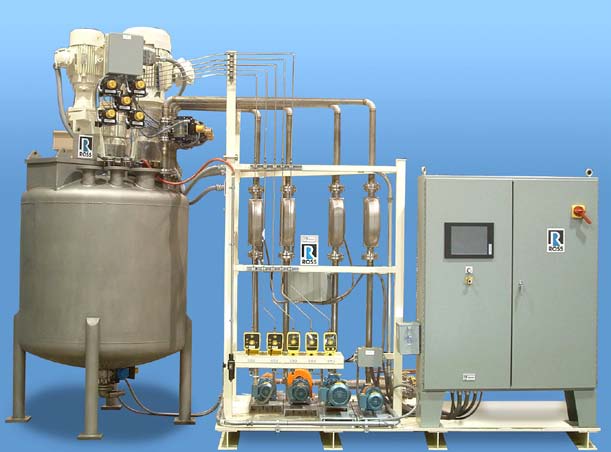
Technology Brief
Multi-agitator mixers are ideal for reaction processes that require intense mixing, high speed dissolution, emulsification, deagglomeration or heating/cooling of viscous liquids.
Role of mixing in chemical reactions
Chemical reactions are often accompanied by mixing. Whether they are combined in a small flask that is swirled by hand or in a hundred-gallon mechanically-stirred vessel, reactants generally undergo reaction faster and/or more completely when mixed properly. Mixing can influence not just reaction rate but also product distribution if more than one product is possible.
At the laboratory scale, the competition between reaction and mixing are not always readily seen. Mixing effects become more critical in industrial reactions where the rates of reaction, mixing and heat transfer approach one another.
Stirred tank reactors
In many industries, the conventional equipment used to carry out chemical reactions is based on a stirred vessel design equipped with a low-speed impeller or turbine-type agitator. These reactors, although effective for most low viscosity applications, can suffer from reduced yield and/or long batch cycle times especially when operations other than straightforward liquid-liquid mixing are involved. For example, potential bottlenecks or inefficiencies can arise in a mildly agitated vessel if the reaction requires dissolution of large particle solids, heating or cooling of viscous liquids, dispersion of agglomerates, emulsification, etc.
Multi-agitator mixer/reactor systems
One way of optimizing mixing-sensitive reactions is through the use of multi-agitator equipment that can provide a unique combination of laminar bulk flow, high shear mixing, particle size reduction and superior heat transfer.
Multi-shaft mixers are composed of two or more independently-driven agitators working in tandem. A low-speed anchor agitator complements one or two high-speed devices such as a saw-tooth disperser and/or a rotor/stator mixer. In combination, these mixing elements can handle viscous reactants that are several hundred thousand centipoise.
The most common anchor designs have two or three wings. This agitator promotes bulk flow and uniform batch temperature while scraping the vessel sidewalls and bottom. For added efficiency in terms of axial flow, the anchor can be modified to feature helical flights in between adjacent wings. The high speed disperser quickly draws solids into the liquid batch through a powerful vortex. The rotor/stator carries out a number of tasks depending on the product characteristics - it can break down agglomerates, accelerate homogenization, or produce fine droplets in an emulsion. Special design rotor/stators are available for sub-surface addition of hard-to-disperse or lightweight powders. For more demanding applications, an inline ultra-high shear mixer (capable of rotor tip speeds up to 11,000 ft/min or higher) may be installed in a recirculation loop connected to the reactor.
Multi-Shaft Mixer Sample Configurations
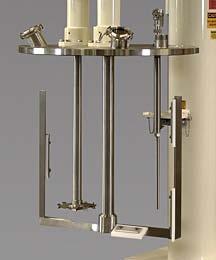
Dual-Shaft Mixer composed of a two-wing anchor with scrapers and a saw-tooth disperser. A temperature probe through the mixer cover is also shown.
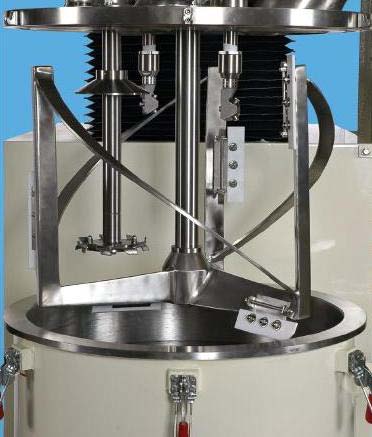
Dual-Shaft Mixer composed of a three-wing anchor with helical flights and scrapers, and a saw-tooth disperser with slinger. Two clean-in-place rotary spray nozzles are also shown.
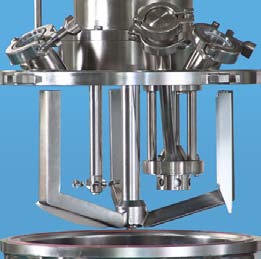
Triple-Shaft Mixer composed of a three-wing anchor with a toriconical bottom profile,a saw-tooth disperser and a rotor/stator with powder induction manifold.
Installation Snapshot: Multi-ShaftMixer/Reactor in an Adhesives & Sealants Production Facility
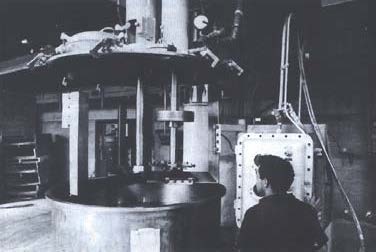
Polymeric Systems, Inc. manufactures specialty adhesivesand sealants mainly for construction and industrial use. One of their products is a one-part gun-grade urethane sealant that is formed by reacting isocyanate and polyether polyol. During the development stage of this particular formulation, a laboratory reactor was used to produce the prepolymer for the sealant and a separate bench-top mixer was utilized to prepare the final product. When the time came to scale up for commercial batches, the company`s engineers began looking into glass and steel production reactors. While comparing costs and performance, it occurred to them that a reactor (whether it is a tank, tube or kettle) does not perform any function other than containing the reaction.
Using a 300-gal Ross VersaMix Multi-Shaft Mixer, a test run of the prepolymer reaction was completed in fewer than two hours. The necessary fillers, plasticizers, thixotropes and adhesion promoters were then added and mixed under deep vacuum. Samples of the sealant tested well, and a productionroutine was established. The current total cycle time is under four hours,half of which is allocated to polymer preparation, the other half to mixing.